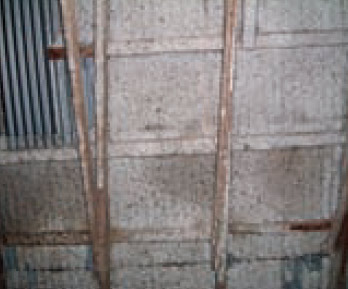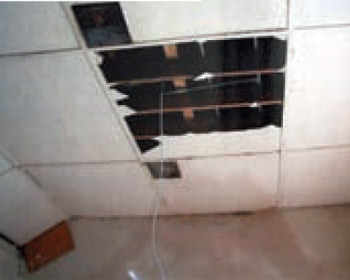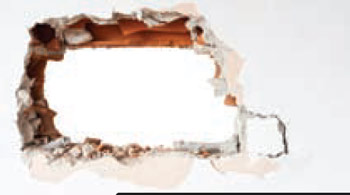| 1. |
Asbestos is a term used for the fibrous forms of several naturally-occurring minerals. All asbestos deposits originate from crystallization of molten rock which, on cooling, produces the various types of fibrous forms. It is usually found as thin veins, up to a few inches thick, between layers of the parent rock, which may be in non-fibrous or crystalline form. |
|
|
up to few inches thick |
|
|
up to few feet thick |
|
|
up to few meters thick |
| 2. |
The presence of asbestos fibers in finished products is not obvious, and the different types of asbestos cannot be distinguished by their visual appearance or color. Laboratory analysis ____________ to identify the type of asbestos. |
|
|
Is required |
|
|
Is not required |
| 3. |
ACMs (asbestos containing material) were widely used in the building and construction industry up until 1999. The majority of buildings built between ______________, during which time asbestos production peaked, contain asbestos in some form. |
|
|
1940 and 1985 |
|
|
1989 and 2007 |
|
|
2005 and 2010 |
| 4. |
Sprayed asbestos was applied as heatproofing, soundproofing and as protection against fire and condensation on beams, connecting pieces and stays made of steel. A mixture of asbestos types was used. Sprayed asbestos is __________ and has a high potential for fiber release unless sealed.
 |
|
|
Is extremely friable |
|
|
Is non-friable |
| 5. |
Loose asbestos lagging was used as a filling material for _______________________for pipe ducts, loft insulation and insulation between floors. |
|
|
heatproofing and soundproofing and as protection against fire |
|
|
simple insulation |
| 6. |
Textured coatings can be found on ceilings and walls. They normally contain Chrysotile asbestos. They were phased out from ____________ but are still widely in place, for example as ‘Artex’ on walls and ceilings in both commercial and domestic buildings. |
|
|
The late 1980s |
|
|
The late 1990s |
|
|
The late 2009 |
| 7. |
Asbestos cement is predominantly ___________________________All three common types of asbestos have been used but Chrysotile (white asbestos) is the most common asbestos type found in asbestos cement. |
|
|
a mixture of cement and asbestos fibers. |
|
|
Cement coated and covered by asbestos fibers. |
| 8. |
Figure 1 shows: |
|
|
The plumbing and electrical diagram of a typical house. |
|
|
Typical location for the most common Asbestos containing material. |
| 9. |
Asbestos is a Category 1 carcinogen and all six types can cause cancer. Blue and brown asbestos are known to be more dangerous than white asbestos. There is no cure for asbestos-related disease. |
|
|
True |
|
|
False |
| 10. |
Asbestos cement products such as roof sheets may sometimes be found in conjunction with other asbestos-containing materials. For example, a warehouse may have an asbestos cement roof which has a sprayed asbestos coating on the inner surface. The presence of this other asbestos-containing material would significantly alter the risk associated with work on the asbestos cement sheets. In these circumstances, more stringent precautions would be required than for work on asbestos cement alone, and the work would need to be carried out |
|
|
by a specialist asbestos contractor. |
|
|
By an experienced contractor. |
| 11. |
An asbestos survey will produce a register of ACMs (commonly known as the asbestos register) and should be provided in a format that is readily comprehensible. Employers must __________________________ . |
|
|
then assess the risks to health from any work that an employee may undertake which may expose them to asbestos and determine what precautions need to be taken to minimize the exposure. |
|
|
Properly record and file the results of the survey. |
| 12. |
The results of the risk assessments will be used to determine __________________________________._____________________________________The total risk will be assessed by the combined risk scores from both the material risk and the priority assessments. The scores will be split into categories, each category indicating the level of prioritization for remedial action as set out in Table 8. |
|
|
To stop the work or not |
|
|
the order of prioritization of remedial actions, including repair, sealing and removal, and the ongoing management of all remaining ACMs within the premises. |
|
|
If a remediation is necessary or not. |
| 13. |
There is a difference in the risk presented by ACMs located inside compared with outside a building. Inside the building the ACMs may be at greater risk of accidental damage or disturbance, and any fibers released may be close to the occupants or accumulate on flat surfaces, pipes etc. and be disturbed later. Such matters ________________________ when making a decision on how to deal with the material.
 |
|
|
need to be taken into account |
|
|
are arbitrary and does not make that much of difference. |
| 14. |
The figure 2 explains |
|
|
The Asbestos management process |
|
|
Air circulation of a Hepa controlled building. |
| 15. |
RDAS (refurbishment/demolition asbestos survey) is the type of asbestos survey is used to locate and describe all ACMs in the area where the refurbishment work will take place or in the whole building if demolition is planned. The survey will involve destructive inspection, as necessary, to gain access to all locations, including those that may be difficult to reach.
 |
|
|
Destructive inspection |
|
|
Non- destructive inspection |
| 16. |
Areas to be sampled inside buildings should be unoccupied, as far as is reasonably practicable, and entry should be restricted, e.g. use of notice ‘KEEP OUT – asbestos sampling in progress’ during the sampling period. |
|
|
True |
|
|
False |
| 17. |
In addition to the basic asbestos awareness training which should be provided to all operatives who work foreseeably be exposed to asbestos whilst carrying out their normal day-to-day work, persons who will intentionally disturb low risk ACMs, such as asbestos cement and textured coatings, |
|
|
should receive additional training, specific to the risks associated with low risk asbestos work. |
|
|
Do not need extra training |
| 18. |
Personal protective equipment (PPE), including respiratory protective equipment (RPE) is the last line of defense against exposure to asbestos fibers, which should be prevented or reduced to as low as is reasonably practicable by engineering controls before RPE is employed. Once it is established that exposure is liable to exceed the control limit of 0.1 f/cm3 despite the precautions taken, RPE must be provided and worn. This will normally include all notifiable asbestos work. |
|
|
True |
|
|
False |
| 19. |
Face fit tests, which involve the individual testing of the face seal on the wearer, must be carried out as part of the initial selection of the RPE and/or where the model of RPE is changed. Due to the high risk nature of asbestos they must also be repeated at least once _________ and if the individual loses or gains weight, undergoes any substantial dental work or develops any other facial changes around the face seal area. The user should also carry out a fit check on every occasion when a respirator is worn to ensure that a good fit has been obtained. |
|
|
12 months |
|
|
24 months |
|
|
36 months |
| 20. |
Recommended colors for different aspects of asbestos work include:
Transit overalls – white
Work area – Red
At other times e.g. soft strips, when sheeting up, de-tenting – Blue
 |
|
|
True |
|
|
False |
|